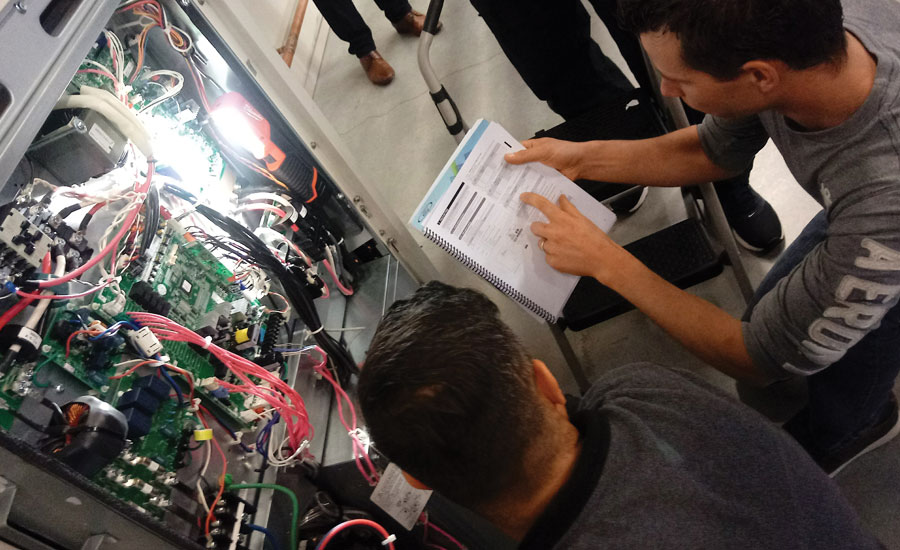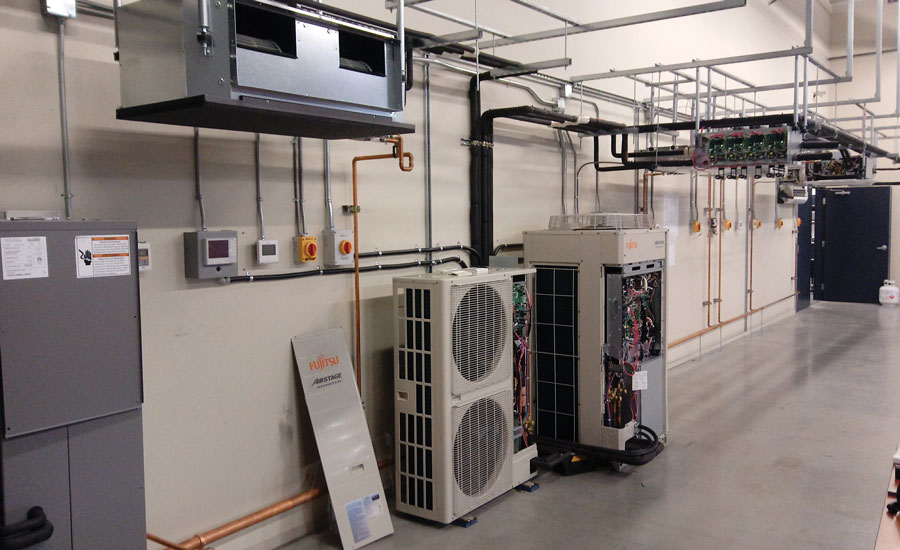Knowledge is Power When it Comes to Variable Refrigerant Flow
Training is paramount in gaining the expertise necessary to adequately manage VRF equipment

PERFORMANCE PREREQUISITE: Most HVACR manufacturers will not grant contractors permission to stock their systems, nor honor equipment warranties, unless they are properly trained and hold the necessary certifications.

TRAINING PHASES: Fujitsu General America’s training curriculum is grouped into two primary categories: J-Series single-phase and V-Series three-phase equipment.

TRAIN THE TRAINER: Fujitsu’s J-Series Installation Training (JSIT) Distributor Qualified Instructor (DQI) course is designed as a “Train the Trainer” course for distributors.

NATIONWIDE SUPPORT: Fujitsu General America operates 14 commercial VRF training centers across the U.S., ranging in location from Maine to California.




With all its piping, brazing, sophisticated controls, and new-age software, variable refrigerant flow (VRF) may seem like a daunting technology to some contractors.
And while it does take some time to learn — and it requires a bit more finesse that a typical split system — many contractors insist, with a little knowledge and practice, most contractors can install a VRF unit.
Training becomes even more crucial when you factor in that most HVACR manufacturers will not grant contractors permission to stock their systems, nor honor equipment warranties, unless installing contractors are properly trained and hold the necessary certifications.
Recognizing the booming demand in the market for VRF comfort, many manufacturers have designed training facilities throughout the U.S. to equip techs with the skills necessary to properly install and maintain the technology. Here’s a look at a few of those facilities.
DAIKIN
Daikin trains techs on its variable refrigerant volume (VRV) equipment through Daikin University. Courses are available at distributor and dealer facilities as well as Daikin authorized training facilities in Carrolton, Texas; Irvine, California; and Long Island City, New York.
The company also opened the doors to Daikin Texas Technology Park (DTTP), a $417 million, 4 million-square-foot campus in Houston, in May 2017. In this space, a lab with seven VRV training systems plays host to a plethora of VRV training courses.
“We teach a three-day installation and commissioning course and offer a service and troubleshooting class, where attendees get their hands on the equipment and figure out how to utilize the equipment and operate the Service Checker data logger,” said Mark Harte, technical training manager, Daikin North America LLC. “The Service Checker gives techs the operating parameters for the indoor and outdoor units and can be a very helpful tool when diagnosing system issues.”
An advanced, one-day data analysis course provides a comprehensive explanation of the Service Checker’s capabilities and demonstrates how techs can better analyze the data it offers.
Daikin also offers VRV S and mini-split training as well as an entire three-day course on controls, which focuses on product applications, hands-on start-up, an informational course on Daikin’s mini-building management system (BMS), and more.
Harte said Daikin intends to add another lab this spring for residential equipment that will include 14 new training systems.
“We have a lot of training already developed, and a lot more is coming soon,” he said. “By the end of this year, we’re aiming to add seven or eight new courses to the curriculum.”
While VRF is an intricate technology, Harte said some HVAC techs simply overthink it.
“Once you break it down and look at it on a refrigerant flow basis, VRV is still a heat pump,” he said. “You troubleshoot it the same way you do a heat pump. It’s still thermodynamics. If you see frosting, you probably have a restriction or a low charge. A lot of guys see all the copper tubing and say, ‘Oh my goodness, I can’t work with that.’ But, once you break it down and simplify the process for them, they tend to get it.”
Harte said training is paramount when it comes to VRV.
“I was a contractor for 20 years, and when I first got to Daikin and started working as a trainer, I was shocked by the number of contractors I saw come through here who didn’t pressure test systems, use evacuation pumps, or use micron gauges to check their vacuum. For the last 11 years, I’ve been constantly hammering on guys how to properly install a system. A tech must take the time to run a triple-evacuation vacuum test. If you do things the right way, you’ll no longer have callbacks.”
FRIEDRICH
Friedrich offers two types of training specific to its variable refrigerant packaged (VRP) product line — one for sales and application representatives and another for service technicians. Product sales and application training are held at least once per year at a representative’s location with teleconference follow-up training throughout the year. This training is designed for the sales engineers who will be specifying and selling the VRP in individual markets.
Service technician training events are held twice a year in the spring and fall at Friedrich’s San Antonio Design and Development Center. This training is for technical personnel who will be providing post-sale service and product support. Both programs are offered for free.
“These training programs include a formal presentation along with a professionally bound handbook to take away some of the points,” said Barry Bookout, director of lodging sales, Friedrich. “Extensive hands-on training that includes VRP installation and service teardown demonstrations in mock-up mechanical closets with working units is also included.”
Friedrich’s sales and application training are typically completed in one full day at a representative’s location. The in-depth service training can typically be completed in two full days.
Bookout said Friedrich’s VRP system is relatively straightforward when it comes to design, application, and installation.
“The VRP is applied and installed in a very similar manner as compared to other single package vertical units on the market,” he said. “The potentially unfamiliar aspect of the product, and therefore the training, revolves around Friedrich’s inverter compressor technology, which includes unique components and controls. A large percentage of the training is focused on understanding and troubleshooting this advanced system utilizing many of the product’s built-in diagnostic features.”
To date, more than 100 sales engineers have completed the sales and application training and approximately 75 service personnel have completed the technical training.
“Friedrich believes that training is invaluable in ensuring the product is applied and supported properly, so we make both the sales and technical training mandatory for companies that want to represent the VRP,” Bookout said. “Not only is Friedrich’s training aimed at getting techs more familiar with the product and application, it will make jobs go more efficiently, meaning techs get the units installed and running faster with less labor and cost.”
FUJITSU
Fujitsu General America operates 14 commercial VRF training centers across the U.S., ranging in location from Maine to California. The training curriculum is grouped into two primary categories: J-Series single-phase and V-Series three-phase equipment. Fujitsu’s J-Series Installation Training (JSIT) is a portable, one-day, instructor-led course for contractors who are interested in 3-5 ton, single-phase VRF equipment only.
“Our single-phase, J-Series training is grouped into eight modules, patterned in order of how an installation progresses, thus making it easy to follow for those new to Airstage VRF as well as VRF in general,” said Wayne DeCosa, Airstage training manager, Fujitsu. “The eight J-Series modules are also available online for contractor technical reference and for Fujitsu continuing education points.”
One of the modules details installation and use of the Service Tool software for start-up, commissioning, and service of Airstage VRF systems.
“Contractors can easily collect operating data, and the Service Tool automates the validation process with a single mouse click,” DeCosa said, “Operating pressures, superheat, subcooling, compressor amperage and speed, and even EEV [electronic expansion valve] positioning for the entire system is displayed on a single page. We have streamlined start-up and service tasks, which no longer require technicians to use their manifold gauges or temperature probes. Our training uses live and recorded data for contractors to become familiar with the Service Tool on their very first installation.
Fujitsu also offers a unique JSIT Distributor Qualified Instructor (DQI) course, which is designed as a “Train the Trainer” course for distributors.
“We understand and deeply appreciate the value our Airstage Distribution network provides,” DeCosa said. “Independent Airstage distributors provide technical training as well as technical support for Fujitsu contractors, and having a Train the Trainer program fast tracks a distributor’s training proficiency, where our mentoring is included as an integral part of the process.”
Additionally, Fujitsu offers instructor-led and online training for use of its Design Simulator software for Airstage system selection.
Fujitsu’s commercial V-Series, three-phase product training is presented via a two-part process. The introductory Regional Airstage Installation Training (RAIT) class is a one-day course for contractors, which provides an intensive introduction to Airstage equipment. Contractors are encouraged to have any and all persons who are involved with installation and service to attend this course.
The second phase of the training encompasses two days at a Fujitsu Training Academy (FTA) and is a blend of practical theory and hands-on training.
“Contractors need only one person from their company to attend the two-day training,” DeCosa said. “Prospective attendees would be a senior installer, service technician, or person who will be involved in the start-up of the equipment. Our objective in training is to provide contractors with everything they need to know for successful installation, start-up, and service of Airstage VRF systems. We are passionate about our VRF systems, training programs, distribution, manufacturing representatives, and contractors. Airstage VRF is literally a transfer of skills HVACR contractors have already, and we remove the mystery behind VRF.”
Completion of the three-phase training also qualifies contractors for the single-phase, J-Series product.
JOHNSON CONTROLS
Johnson Controls Inc. (JCI) opened the doors to its 12,600-square-foot training facility in Dallas in July 2015. The center boasts a hands-on lab, one 25-person and one 15-person classroom, audio/video conferencing capabilities, and a full curriculum to help HVAC contractors and sales professionals deliver quality VRF solutions.
“Since opening our doors in mid-2015, more than 1,400 graduates have completed the course,” said Justin Patrick, vice president and general manager, VRF and Ductless Products, North America, Johnson Controls Inc. “Additionally, we’ve upgraded our training lab to include our duct-free mini-split product line as well as our second-generation of VRF systems.
“Our staff has grown significantly since 2015, and the training facility now includes our dedicated customer service, technical support, warranty, selection software, and product teams,” Patrick continued. “Last month, we opened a second VRF training facility in Shrewsbury, Pennsylvania, that will also host a lab and full VRF curriculum.”
Attendees tend to spend one to three days in training, learning about installation and commissioning, controls, mini splits, mini VRF, and more.
“Classes are broken up into categories to give our customers the option to send certain individuals to training who specialize in that particular field,” Patrick said. “For example, a controls specialist would benefit significantly by attending the controls class, whereas pipefitters would likely attend just the installation class. This format allows the training team to create materials that are more in depth and suited to the specialty of the individual.”
LG
LG offers a broad array of courses from basic engineering and product classes for building owners to installation, commissioning, and advanced service classes for contractors through four locations in Alpharetta, Georgia; Orange Country, California; Dallas; and Secaucus, New Jersey.
The manufacturer offers six courses focused on its Multi V systems ranging from installation essentials to engineering and product training to controls. Courses range from one to three days.
Chuck Darway, vice president of ACCO Engineered Systems, a Glendale, California-based mechanical contractor, has completed LG’s VRF training and works closely with the manufacturer’s team to provide feedback from the field.
“We’ve worked very closely with LG’s engineering team, which has helped us gain exposure to things early on that may be problematic,” Darway said. “If they’re coming out with new software or equipment or developed a bug, we can plan for that better through that open communication we have with them. That ability to pass info back and forth has made us more apt to use their systems.”
Publication date: 2/5/2018
Want more HVAC industry news and information? Join The NEWS on Facebook, Twitter, and LinkedIn today!














